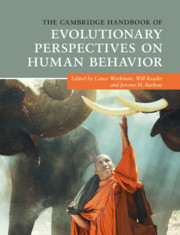Book contents
- The Cambridge Handbook of Evolutionary Perspectives on Human Behavior
- The Cambridge Handbook of Evolutionary Perspectives on Human Behavior
- Copyright page
- Dedication
- Contents
- Figures
- Tables
- Contributors
- Preface
- Acknowledgments
- Part I The Comparative Approach
- Part II Sociocultural Anthropology and Evolution
- Part III Evolution and Neuroscience
- Part IV Group Living
- Part V Evolution and Cognition
- Part VI Evolution and Development
- 21 Evolutionary Developmental Psychology
- 22 The Ontogeny and Evolution of Cooperation
- 23 Genomic Imprinting Is Critical for Understanding the Development and Adaptive Design of Psychological Mechanisms in Humans and Other Animals
- 24 Evolutionary Explanations for Bullying Behavior
- 25 Birth Order and Evolutionary Psychology
- Part VII Sexual Selection and Human Sex Differences
- Part VIII Abnormal Behavior and Evolutionary Psychopathology
- Part IX Applying Evolutionary Principles
- Part X Evolution and the Media
- Index
- References
21 - Evolutionary Developmental Psychology
Developing Adaptations in Infancy and Childhood
from Part VI - Evolution and Development
Published online by Cambridge University Press: 02 March 2020
- The Cambridge Handbook of Evolutionary Perspectives on Human Behavior
- The Cambridge Handbook of Evolutionary Perspectives on Human Behavior
- Copyright page
- Dedication
- Contents
- Figures
- Tables
- Contributors
- Preface
- Acknowledgments
- Part I The Comparative Approach
- Part II Sociocultural Anthropology and Evolution
- Part III Evolution and Neuroscience
- Part IV Group Living
- Part V Evolution and Cognition
- Part VI Evolution and Development
- 21 Evolutionary Developmental Psychology
- 22 The Ontogeny and Evolution of Cooperation
- 23 Genomic Imprinting Is Critical for Understanding the Development and Adaptive Design of Psychological Mechanisms in Humans and Other Animals
- 24 Evolutionary Explanations for Bullying Behavior
- 25 Birth Order and Evolutionary Psychology
- Part VII Sexual Selection and Human Sex Differences
- Part VIII Abnormal Behavior and Evolutionary Psychopathology
- Part IX Applying Evolutionary Principles
- Part X Evolution and the Media
- Index
- References
Summary
Evolutionary developmental psychology examines development through the lens of evolutionary theory. We first discuss adaptations of infancy and childhood, including ontogenetic, deferred, and conditional adaptations. The important ontogenetic adaptations reviewed include neonatal imitation and cognitive immaturity during childhood. Sex differences in play style as deferred adaptations are also discussed. Conditional adaptations, with children adjusting their developmental trajectory as a function of early life conditions, are examined from the perspective of life history theory. We then provide a framework for how adaptations develop, discussing evolved probabilistic cognitive mechanisms, evolved information-processing mechanisms that are expressed in a probabilistic fashion in each individual in a generation based on the continuous and bidirectional interaction over time at all levels of organization, from the genetic through the cultural. We provide examples of evolved probabilistic cognitive mechanisms from the domains of infant face perception, social learning, prepared fears, and tool use. Adaptations are central to an evolutionary psychological explication, and understanding how such adaptations develop enhances our understanding of adaptations.
- Type
- Chapter
- Information
- Publisher: Cambridge University PressPrint publication year: 2020
References
- 1
- Cited by



